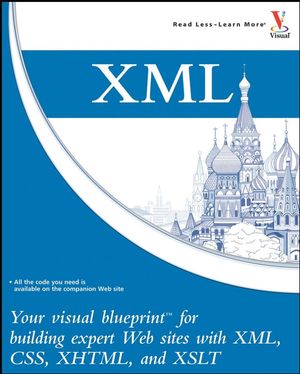XML: Your visual blueprint for building expert websites with XML, CSS, XHTML, and XSLTISBN: 978-0-471-93383-0
Paperback
304 pages
November 2007
 This title is out-of-print and not currently available for purchase from this site.
|
1 GETTING STARTED WITH XML.
Introducing XML.
Introducing XSLT.
Introducing XHTML.
Introducing CSS.
View XML in a Browser.
Introducing the Anatomy of an XML Document.
Choose a Good Text Editor.
2 CREATING XML DOCUMENTS.
Create Your First XML Document.
Add Child Elements and Data to Your Document.
Add Attributes.
Add Entities and CDATA.
Using a Namespace.
3 DEFINING THE STRUCTURE OF XML WITH SCHEMAS.
Introducing Schemas.
Using the Schema Namespace.
Add Complex Type Elements.
Add Data Types.
Add Attributes.
Add Simple Elements.
Add Mixed Elements.
Restrict the Recurrence of Elements.
Link Your XML to Your Schema.
Check the Validity of the Document.
Build a Schema Visually Using XMLSpy.
4 USING OTHER VALIDATION SCHEMAS.
Introducing DTDs.
Create a Simple DTD.
Add Attributes.
Add Entities.
Using Parameter Entities.
Introducing RELAX NG.
Create a RELAX NG Document in XML.
Using the RELAX NG Compact Syntax.
5 GENERATING XML FROM EXISTING DATA.
Using Microsoft Access 2003 to Generate XML.
Using Microsoft Access 2007 to Generate XML.
Using Microsoft Excel 2003 to Generate XML.
Using Microsoft Excel 2007 to Generate XML.
6 LEARNING XHTML BASICS.
Introducing XHTML.
Create a Basic XHTML Transitional Page.
Add a Title.
Add Headings.
Add Text.
Using Entities.
Add a Link.
Add an Image.
Add a Table.
Create Lists.
7 TRANSFORMING XML TO XHTML WITH XSLT.
Understanding XSLT.
Understanding the XSLT Namespace.
Understanding XPath.
Specify an Output Format.
Create an XSLT Template.
Transform Element Values.
Add Text to the Transformation.
Apply Templates.
Loop with XSLT.
Sort with XSLT.
Using Conditional Logic in XSLT.
Create an Element.
Include and Import Other XSLT Files.
Using Variables and Parameters.
Run the Transformation with a Web Browser.
Run the Transformation Using Altova XMLSpy.
Run the Transformation Using PHP.
Run the Transformation Using Adobe ColdFusion.
Run the Transformation Using ASP.NET.
Create an XSLT Document Using Adobe Dreamweaver CS3.
8 FORMATTING YOUR WEB SITE USING CSS.
Understanding CSS.
Change the Font.
Change the Color of Text.
Add a Background Color and Image.
Add Borders.
Add Padding and Margins.
Position Elements.
Float Elements.
Combine Floats, Positioning, and Margins for Layout.
Apply Styles with a Class Selector.
Apply Styles with an ID Selector.
Using Contextual Selectors.
Style Headings.
Style Lists.
Style Links.
Using Other Pseudo-Classes and Pseudo-Elements.
Design Content Sections.
Create a Style Guide.
Create a Printable Version of Your Web Pages.
Create a Version of Your Page for Handheld Devices.
9 TRANSLATING LEGACY HTML TO XHTML.
Clean Up HTML with Tidy.
Convert HTML to XHTML Using Adobe Dreamweaver.
Remove Presentational Markup Using Dreamweaver’s Find and Replace.
Strip Tables in Dreamweaver.
Add Alternative Text to All Images.
10 DESIGNING AND BUILDING YOUR WEB SITE.
Lay Out Your Folder Structure.
Plan Your Site’s Navigation.
Create an Index Page.
Create an About You XML File.
Translate the About You File to XHTML.
Create a Favorite Movies XML File.
Translate the Favorite Movies File to XHTML.
Add a Site Icon.
Put Some Advertising on Your Site.
11 PUBLISHING YOUR WEB SITE.
Find a Host.
Get a Domain Name.
Publish Your Web Site Using Windows FTP.
Publish Your Web Site Using Adobe Dreamweaver.
Publish Your Web Site Using SmartFTP.
Get Your Site Found by Search Engines.
12 TESTING AND DEBUGGING.
Validate Your XHTML.
Debug with Firebug.
Validate CSS.
Check Your Site’s Accessibility.
Test Your Links.
Avoid Common XML Mistakes.
Avoid Common XHTML Mistakes.
Avoid Common CSS Mistakes.
Avoid Common XSLT Mistakes.
Avoid Common Browser-Specific Mistakes.
Avoid Common Usability Mistakes.
13 INTEGRATING YOUR WEB SITE WITH OTHER WEB SITES.
Understanding RSS.
Create an RSS Feed.
Show Your Photos with Flickr.
Embed a YouTube Video on Your Site.
Show Your del.icio.us Links.
Embed a Google Map on Your Site.
Add Google Search to Your Site.
APPENDIX A XHTML REFERENCE.
APPENDIX B CSS REFERENCE.
APPENDIX C XSD REFERENCE.
APPENDIX D XSLT REFERENCE.
APPENDIX E XPATH REFERENCE.



